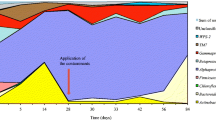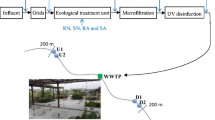Abstract
Two reactors, initially operated at 14 and 23±1°C (RA and RB, respectively), were inoculated with a bacterial consortium enriched and acclimatized to the respective temperatures over 4 months. The biofilms, formed in the reactors, were studied using scanning electron microscopy, cultivation of the biofilm microflora, and physiological analysis of the isolates. Two bacteria able to mineralize chlorophenols under a large range of temperature (10–30°C) were isolated from the biofilm communities of reactors RA and RB and characterized as Alcaligenaceae bacterium R14C4 and Cupriavidus basilensis R25C6, respectively. When temperature was decreased by 10°C, the chlorophenols removal capacity was reduced from 51.6 to 22.8 mg l−1 h−1 in bioreactor RA (from 14 to 4°C) and from 59.3 to 34.7 mg l−1 h−1 in bioreactor RB (from 23±1 to 14°C). Fluorescence in situ hybridization (FISH) of the biofilm communities showed that, in all temperatures tested, the β-proteobacteria were the major bacterial community (35–47%) followed by the γ-proteobacteria (12.0–6.5%). When the temperature was decreased by 10°C, the proportions of γ-proteobacteria and Pseudomonas species increased significantly in both microbial communities.


Similar content being viewed by others
References
Amann R, Ludwig W, Schleifer K (1995) Phylogenetic identification and in situ detection of individual microbial cells without cultivation. Microbiol Rev 59:143–169
Amann R, Fuchs BM, Behrens S (2001) The identification of microorganisms by fluorescence in situ hybridization. Curr Opin Biotechnol 12:231–236
Bjornsson L, Hugenholtz P, Tyson GW, Blackall LL (2002) Filamentous Chloroflexi (green non-sulfur bacteria) are abundant in wastewater treatment processes with biological nutrient removal. Microbiology 148:2309–2318
Bouches T, Dabert P, Wagner M, Godon JJ, Molleta R (2001) Quantification of bacterial populations in complex ecosystems using fluorescent in situ hybridization, confocal laser scanning microscopy and image analysis. Genet Sel Evol 33:S307–S318
Boyer SL, Flechtner VR, Johansen JR (2001) Is the 16S–23S rRNA internal transcribed spacer region a good tool for use in molecular systematics and population genetics? A case study in cyanobacteria. Mol Biol Evol 18:1057–1069
Braun-Howland EB, Vescio PA, Nierzwicki-Bauer SA (1993) Use of a simplified cell blot technique and 16S rRNA-directed probes for identification of common environmental isolates. Appl Environ Microbiol 59:3219–3224
Caldeira M, Heald SC, Carvalho MF, Vasconcelos I, Bull AT, Castro PML (1999) 4-Chlorophenol degradation by a bacterial consortium: development of a granular activated carbon biofilm reactor. Appl Microbiol Biotechnol 52:722–729
Clémenta P, Matusa V, Cardenasb L, Gonzaleza B (1995) Degradation of trichlorophenols by Alcaligenes eutrophus JMP134. FEMS Microbiol Lett 127:51–55
Daffonchio D, Borin S, Frova G, Manachini P, Sorlini C (1998) PCR fingerprinting of whole genomes: the spacers between the 16S and 23S rRNA genes and of intergenic tRNA gene regions reveal a different intraspecific genomic variability of Bacillus cereus and Bacillus licheniformis. Int J Syst Bacteriol 48:107–116
Daims H, Bruhl A, Amann R, Schleifer KH, Wagner M (1999) The domain-specific probe EUB338 is insufficient for the detection of all bacteria: development and evaluation of a more comprehensive probe set. Syst Appl Microbiol 22:434–444
Davey ME, O’Toole GA (2000) Microbial biofilms: from ecology to molecular genetics. Microbiol Mol Biol Rev 64:847–867
De Boer W, Leveau JHJ, Kowalchuk GA, Gunnewiek PJAK, Abeln ECA, Figge MJ, Sjollema K, Janse JD, Van Veen JA (2004) Collimonas fungivorans gen. nov., sp. nov., a chitinolytic soil bacterium with the ability to grow on living fungal hyphae. Int J Syst Evol Microbiol 54:857–864
Delille D, Coulon F, Pelletier E (2004) Effect of temperature warming during a bioremediation study of natural and nutrient-amended hydrocarbon-contaminated sub-Antarctic soils. Cold Reg Sci Technol 40:61–70
Futamata H, Harayama S, Watanabe K (2001) Group-specific monitoring of phenol hydroxylase genes for a functional assessment of phenol-stimulated trichloroethylene bioremediation. Appl Environ Microbiol 67:4671–4677
Guieysse B, Cirne MDTG, Mattiasson B (2001) Microbial degradation of phenanthrene and pyrene in a two-liquid phase-partitioning bioreactor. Appl Microbiol Biotechnol 56:796–802
Guieysse B, Mattiasson B (1999) Fast remediation of coal-tar-related compounds in biofilm bioreactors. Appl Microbiol Biotechnol 52:600–607
Hugenholtz P, Tyson GW, Blackall LL (2001) Design and evaluation of 16S rRNA-targeted oligonucleotide probes for fluorescence in situ hybridization. In: Lieberman BA (ed) Methods in molecular biology, vol 176: steroid receptor methods: protocols and analysis. Humana, Totawa, NJ, pp 29–41
Langwaldt JH, Puhakka JA (2000) On-site biological remediation of contaminated groundwater, a review. Environ Pollut 107:187–197
Mannisto M, Tiirola M, Salkinoja-Salonen M, Kulomaa M, Puhakka JA (1999) Diversity of chlorophenol-degrading bacteria isolated from contaminated boreal groundwater. Arch Microbiol 171:189–197
Manolov B, Hånkansson K, Guieysse B (2005) Continuous acetonitrile degradation in a packed-bed bioreactor. Appl Microbiol Biotechnol 66:567–574
Manz W, Amann R, Ludwig W, Vancanneyt M, Schleifer KH (1996) Application of a suite of 16S rRNA-specific oligonucleotide probes designed to investigate bacteria of the phylum Cytophage-Flavobacter-Bacteroides in the natural environment. Microbiol 142:1097–1106
Manz W, Amann R, Ludwig W, Wagner M, Schleifer KH (1992) Phylogenetic oligonucleotide probes for the major subclasses of proteobacteria: problems and solutions. Syst Appl Microbiol 15:593–600
Margesin R, Schinner F (1994) Properties of cold-adapted microorganisms and their potential role in biotechnology. J Biotechnol 33:1–14
Meier H, Amann R, Ludwig W, Schleifer KH (1999) Specific oligonucleotide probes for in situ detection of a major group of Gram-positive bacteria with low DNA G+C content. Syst Appl Microbiol 22:186–196
Moter A, Gobel UB (2000) Fluorescence in situ hybridization (FISH) for direct visualization of microorganisms. J Microbiol Methods 41:85–112
Roller C, Wagner M, Amann R, Ludwig W, Schleifer KH (1994) In situ probing of gram-positive bacteria with high DNA G+C content using 23S rRNA-targeted oligonucleotides. Microbiol 140:2849–2858
Sambrook J, Fritsch EF, Maniatis T (1989) Molecular cloning: a laboratory manual. Cold Spring Harbor Laboratory, Cold Spring Harbor, NY
Schleifer KH, Amann R, Ludwig W, Rothemund C, Springer N, Dorn S (1992) Nucleic acid probes for the identification and in situ detection of pseudomonads. In: Galli E, Silver S, Witholt B (eds) Pseudomonas: molecular biology and biotechnology. American Society for Microbiology, Washington, pp 127–133
Soares A, Murto M, Guieysse B, Mattiasson B (2006) Biodegradation of nonylphenol in a continuous bioreactor at low temperatures and effects in the microbial populations. Appl Microbiol Biotechnol 69:597–606
Stahl DA, Amann R (1991) Development and application of nucleic acid probes. In: Stackebrandt E, Goodfellow M (eds) Nucleic acid techniques in bacterial systematics. Wiley, New York, pp 205–248
Stamper DM, Radosevich M, Hallberg KB, Traina SJ, Tuovinen OH (2002) Ralstonia basilensis M91-3, a denitrifying soil bacterium capable of using s-triazines as nitrogen sources. Can J Microbiol 48:1089–1098
Steinle P, Stucki G, Stettler R, Hanselmann KW (1998) Aerobic mineralization of 2,6-dichlorophenol by Ralstonia sp. strain RK1. Appl Environ Microbiol 64:2566–2571
Stoodley P, Sauer K, Davies DG, Costerton JW (2002) Biofilms as complex differentiated communities. Annu Rev Microbiol 56:187–209
Tani K, Muneta M, Nakamura K, Shibuya K, Nasu M (2002) Monitoring of Ralstonia eutropha KT1 in groundwater in an experimental bioaugmentation field by in situ PCR. Appl Environ Microbiol 68:412–416
Toole GO, Kaplan HB, Kolter R (2000) Biofilm formation as microbial development. Annu Rev Microbiol 54:49–79
Vandamme P, Coenye T (2004) Taxonomy of the genus Cupriavidus: a tale of lost and found. Int J Syst Evol Microbiol 54:2285–2289
Wallner G, Amann R, Beisker W (1993) Optimizing fluorescent in situ hybridization with rRNA-targeted oligonucleotide probes for flow cytometric identification of microorganisms. Cytometry 14:136–143
Watanabe K, Hamamura N (2003) Molecular and physiological approaches to understanding the ecology of pollutant degradation. Curr Opin Biotechnol 14:289–295
Weisburg WG, Barns SM, Pelletier D, Lane DJ (1991)16S Ribosomal DNA amplification for phylogenetic study. J Bacteriol 173:967–703
Whiteley AS, Bailey MJ (2000) Bacterial community structure and physiological state within an industrial phenol bioremediation system. Appl Environ Microbiol 66:2400–2407
Yeates C, Saunders AM, Crocetti GR, Blackall LL (2003) Limitations of the widely used GAM42a and BET42a probes targeting bacteria in the Gammaproteobacteria radiation. Microbiol 149:1239–1247
Acknowledgements
This research was funded by SIDA (the Swedish International Development Cooperation Agency). The ministry of science, research, and technology of the Islamic Republic of Iran provided financial support to Hamid Zilouei. The Portuguese Fundacao para a Ciencia e a Tecnologia is also acknowledged for supporting Ana Soares through grant BD/13083/2003.
Author information
Authors and Affiliations
Corresponding author
Rights and permissions
About this article
Cite this article
Zilouei, H., Soares, A., Murto, M. et al. Influence of temperature on process efficiency and microbial community response during the biological removal of chlorophenols in a packed-bed bioreactor. Appl Microbiol Biotechnol 72, 591–599 (2006). https://doi.org/10.1007/s00253-005-0296-z
Received:
Revised:
Accepted:
Published:
Issue Date:
DOI: https://doi.org/10.1007/s00253-005-0296-z




